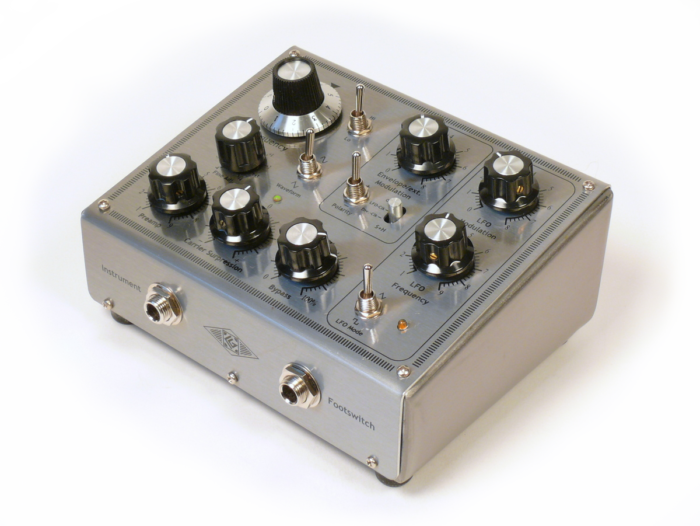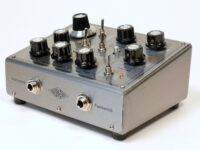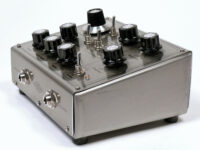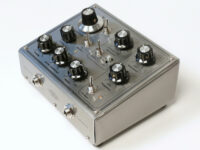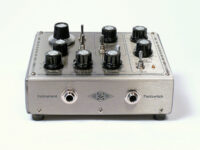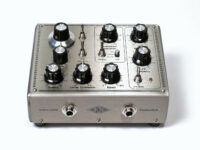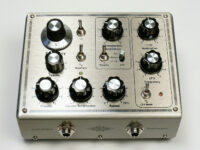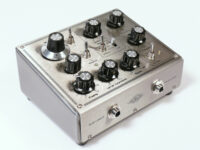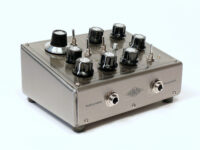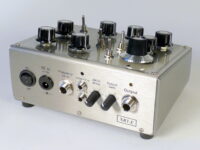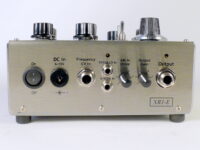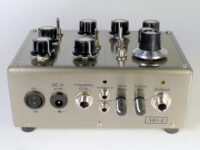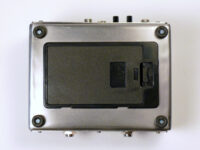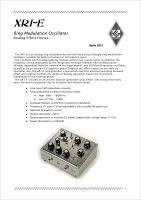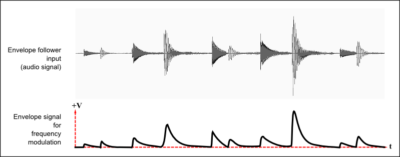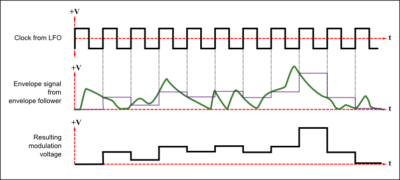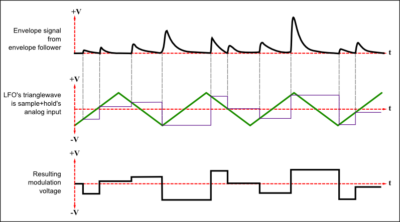XR1-E
Ring Modulation Oscillator
Features:
-
Low noise preamp
-
Bicolor LED for visual control
-
Frequency modulation with envelope follower, LFO and/or Sample+Hold
-
1V/oct minijack input and 2nd input for external frequency control
-
Clock input for Sample+Hold
-
Footswitch input – true bypass
-
Adjustable output gain
-
Battery (6x AA) or with external DC supply
(Current @9V: ≈155mA) -
Unique handmade casing

The XR1-E is an analog ring modulator with internal oscillator, preamp and LFO in a nice hand- made casing.
With a wide variety of control possibilties, the range of sound options reaches from the typical ring modulation and tremolo-like waveforms to glissando and random-like patterns or distortion.
» read more
An integrated low-noise preamp (with much headroom) is allowing to adapt all kind of input sources, such as microphones, e-guitars or electronic instruments. Optical overview of the oscillator’s and preamp’s overdrive behaviour provides a bicolor LED.
The frequency is manually adjustable by knobs for coarse and fine tuning and a switch for high or low (tremolo) range. An envelope follower, a LFO and a Sample+Hold may be used for frequency modulation. The envelope CV can be optionally replaced by an external signal or a voltage from a foot pedal, appliable on a jack on the rear. Further, a minijack 1V/oct. input is available for controlling the XR1-E’s frequency by an external CV.
The XR1-E has a footswitch input on its front to apply an external footswitch (not included) for switching between the effect and the original (true bypass). The output level of the processed signal can be aligned by a knob on the rear. Due to the ability of battery operation the device is independent from external power supply, but there is a socket for a DC adaptor too (DC adaptor not included).
The XR1-E is based on a function generator chip, which warm and smooth sound makes it excellently suitable for ring modulation and electronic music.
Please note: Due to the handmade manufacturing process, there may be some little scratches/irregularities in the casing’s surface.
» read less
» read more
An integrated low-noise preamp (with much headroom) is allowing to adapt all kind of input sources, such as microphones, e-guitars or electronic instruments. Optical overview of the oscillator’s and preamp’s overdrive behaviour provides a bicolor LED.
The frequency is manually adjustable by knobs for coarse and fine tuning and a switch for high or low (tremolo) range. An envelope follower, a LFO and a Sample+Hold may be used for frequency modulation. The envelope CV can be optionally replaced by an external signal or a voltage from a foot pedal, appliable on a jack on the rear. Further, a minijack 1V/oct. input is available for controlling the XR1-E’s frequency by an external CV.
The XR1-E has a footswitch input on its front to apply an external footswitch (not included) for switching between the effect and the original (true bypass). The output level of the processed signal can be aligned by a knob on the rear. Due to the ability of battery operation the device is independent from external power supply, but there is a socket for a DC adaptor too (DC adaptor not included).
The XR1-E is based on a function generator chip, which warm and smooth sound makes it excellently suitable for ring modulation and electronic music.
Please note: Due to the handmade manufacturing process, there may be some little scratches/irregularities in the casing’s surface.
The frequency is manually adjustable by knobs for coarse and fine tuning and a switch for high or low (tremolo) range. An envelope follower, a LFO and a Sample+Hold may be used for frequency modulation. The envelope CV can be optionally replaced by an external signal or a voltage from a foot pedal, appliable on a jack on the rear. Further, a minijack 1V/oct. input is available for controlling the XR1-E’s frequency by an external CV.
The XR1-E has a footswitch input on its front to apply an external footswitch (not included) for switching between the effect and the original (true bypass). The output level of the processed signal can be aligned by a knob on the rear. Due to the ability of battery operation the device is independent from external power supply, but there is a socket for a DC adaptor too (DC adaptor not included).
The XR1-E is based on a function generator chip, which warm and smooth sound makes it excellently suitable for ring modulation and electronic music.
Please note: Due to the handmade manufacturing process, there may be some little scratches/irregularities in the casing’s surface.
» read less

Sounds
XR1-E with microphone and trumpet
XR1-E with electric guitar
XR1-E with metallophone
XR1-E with synthesizer piano
XR1-E with rhythm machine and different sample+hold settings
Or listen on
https://soundcloud.com/cg-products/sets/xr1-e
Video


Sample+Hold Mode
for oscillator frequency modulation

Switch ‘S+H’ in middle position
LFO-Clk
- LFO is the Sample+Hold’s clock;
- Envelope shape is the S+H’s analog input signal

List of specifications
- Power Supply
- 6x AA Mignon cells or
- External power adaptor 6-15V, 200mA (not included)
- Oscillator Frequency
- Hi: ≈ 8Hz – 18000Hz
- Lo: ≈ 0,2 Hz – 60Hz
- Instrument Input
- Impedance: ≈380kΩ
- Max. input voltage: 6-8Vpp
- Dimensions
- 14,2 x 8,3 x11,0 cm
- Input/Output Sockets
- Audio out
- External frequency CV in (3pole, with +5V voltage source for e.g. pedal)
- 1V/oct minijack input
- External clock input for Sample+Hold (minijack)
- External DC in – 2,1mm DC jack
- Instrument signal in
- Footswitch in
- Potentiometers
- Oscillator frequency
- Oscillator frequency fine tuning
- Preamp gain
- Carrier (oscillator tone) surpression
- Bypass (signal to effect ratio)
- Envelope follower/ext. CV modulation depth
- LFO frequency
- LFO modulation depth
- Output gain (back side)
- AM drive (back side)
- Switches
- Power on/off (back side)
- Oscillator frequency: low/high
- Oscillator waveform: triangle/sinusoidal
- Envelope follower: inverse modulation
- Env./Sample+Hold mode
- LFO waveform: triangle/square

